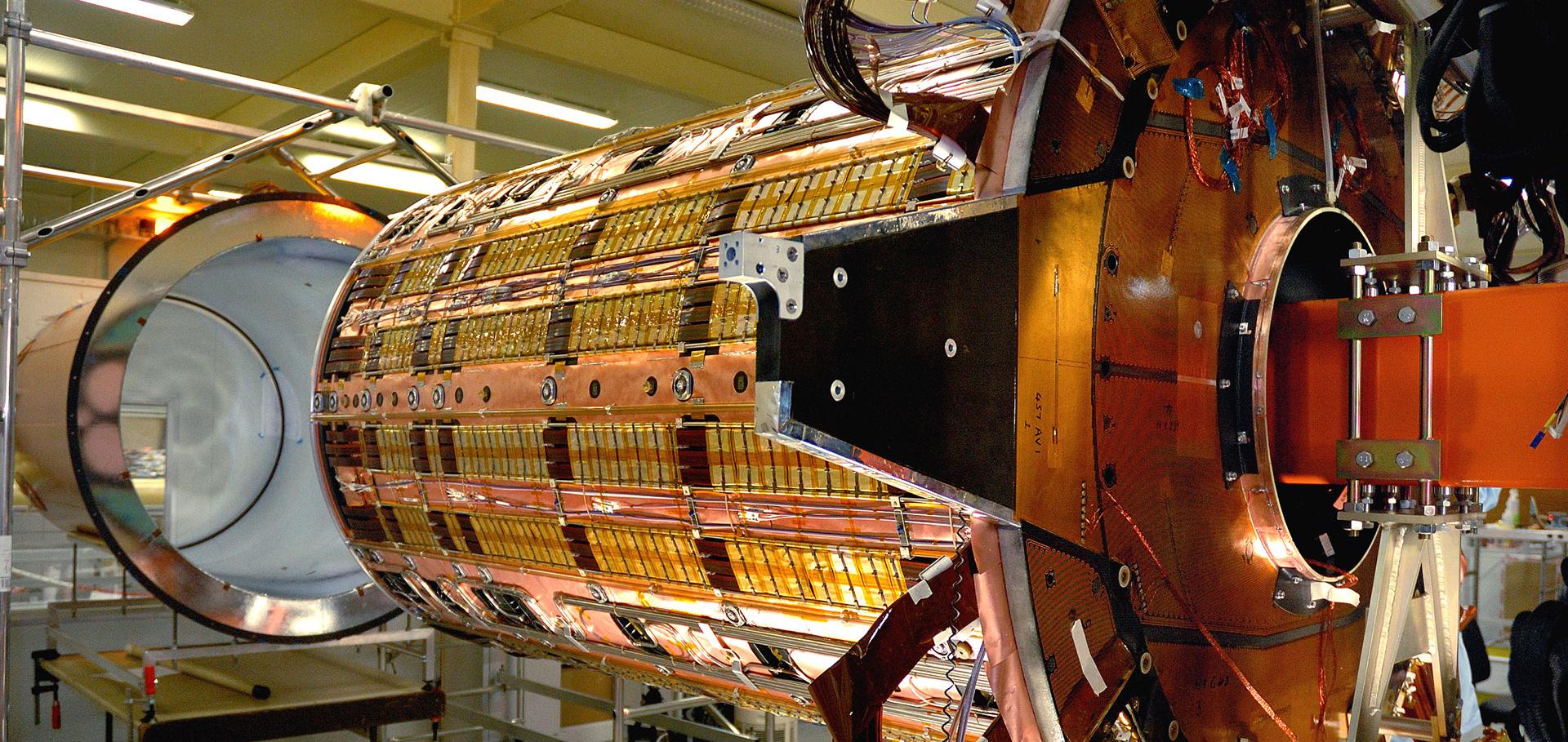Observation of electron neutrino appearance in a muon neutrino beam.
Phys Rev Lett 112:6 (2014) 061802
Authors:
K Abe, J Adam, H Aihara, T Akiri, C Andreopoulos, S Aoki, A Ariga, T Ariga, S Assylbekov, D Autiero, M Barbi, GJ Barker, G Barr, M Bass, M Batkiewicz, F Bay, SW Bentham, V Berardi, BE Berger, S Berkman, I Bertram, S Bhadra, FDM Blaszczyk, A Blondel, C Bojechko, S Bordoni, SB Boyd, D Brailsford, A Bravar, C Bronner, N Buchanan, RG Calland, J Caravaca Rodríguez, SL Cartwright, R Castillo, MG Catanesi, A Cervera, D Cherdack, G Christodoulou, A Clifton, J Coleman, SJ Coleman, G Collazuol, K Connolly, L Cremonesi, A Dabrowska, I Danko, R Das, S Davis, P de Perio, G De Rosa, T Dealtry, SR Dennis, C Densham, F Di Lodovico, S Di Luise, O Drapier, T Duboyski, K Duffy, F Dufour, J Dumarchez, S Dytman, M Dziewiecki, S Emery, A Ereditato, L Escudero, AJ Finch, L Floetotto, M Friend, Y Fujii, Y Fukuda, AP Furmanski, V Galymov, A Gaudin, S Giffin, C Giganti, K Gilje, D Goeldi, T Golan, JJ Gomez-Cadenas, M Gonin, N Grant, D Gudin, DR Hadley, A Haesler, MD Haigh, P Hamilton, D Hansen, T Hara, M Hartz, T Hasegawa, NC Hastings, Y Hayato, C Hearty, RL Helmer, M Hierholzer, J Hignight, A Hillairet, A Himmel, T Hiraki, S Hirota, J Holeczek, S Horikawa, K Huang, AK Ichikawa, K Ieki, M Ieva, M Ikeda, J Imber, J Insler, TJ Irvine, T Ishida, T Ishii, SJ Ives, K Iyogi, A Izmaylov, A Jacob, B Jamieson, RA Johnson, JH Jo, P Jonsson, CK Jung, AC Kaboth, T Kajita, H Kakuno, J Kameda, Y Kanazawa, D Karlen, I Karpikov, E Kearns, M Khabibullin, A Khotjantsev, D Kielczewska, T Kikawa, A Kilinski, J Kim, J Kisiel, P Kitching, T Kobayashi, L Koch, A Kolaceke, A Konaka, LL Kormos, A Korzenev, K Koseki, Y Koshio, I Kreslo, W Kropp, H Kubo, Y Kudenko, S Kumaratunga, R Kurjata, T Kutter, J Lagoda, K Laihem, I Lamont, M Laveder, M Lawe, M Lazos, KP Lee, C Licciardi, T Lindner, C Lister, RP Litchfield, A Longhin, L Ludovici, M Macaire, L Magaletti, K Mahn, M Malek, S Manly, AD Marino, J Marteau, JF Martin, T Maruyama, J Marzec, EL Mathie, V Matveev, K Mavrokoridis, E Mazzucato, M McCarthy, N McCauley, KS McFarland, C McGrew, C Metelko, M Mezzetto, P Mijakowski, CA Miller, A Minamino, O Mineev, S Mine, A Missert, M Miura, L Monfregola, S Moriyama, Th A Mueller, A Murakami, M Murdoch, S Murphy, J Myslik, T Nagasaki, T Nakadaira, M Nakahata, T Nakai, K Nakamura, S Nakayama, T Nakaya, K Nakayoshi, D Naples, C Nielsen, M Nirkko, K Nishikawa, Y Nishimura, HM O'Keeffe, R Ohta, K Okumura, T Okusawa, W Oryszczak, SM Oser, RA Owen, Y Oyama, V Palladino, V Paolone, D Payne, GF Pearce, O Perevozchikov, JD Perkin, Y Petrov, LJ Pickard, ES Pinzon Guerra, C Pistillo, P Plonski, E Poplawska, B Popov, M Posiadala, J-M Poutissou, R Poutissou, P Przewlocki, B Quilain, E Radicioni, PN Ratoff, M Ravonel, MAM Rayner, A Redij, M Reeves, E Reinherz-Aronis, F Retiere, A Robert, PA Rodrigues, P Rojas, E Rondio, S Roth, A Rubbia, D Ruterbories, R Sacco, K Sakashita, F Sánchez, F Sato, E Scantamburlo, K Scholberg, J Schwehr, M Scott, Y Seiya, T Sekiguchi, H Sekiya, D Sgalaberna, M Shiozawa, S Short, Y Shustrov, P Sinclair, B Smith, RJ Smith, M Smy, JT Sobczyk, H Sobel, M Sorel, L Southwell, P Stamoulis, J Steinmann, B Still, Y Suda, A Suzuki, K Suzuki, SY Suzuki, Y Suzuki, T Szeglowski, R Tacik, M Tada, S Takahashi, A Takeda, Y Takeuchi, HK Tanaka, HA Tanaka, MM Tanaka, D Terhorst, R Terri, LF Thompson, A Thorley, S Tobayama, W Toki, T Tomura, Y Totsuka, C Touramanis, T Tsukamoto, M Tzanov, Y Uchida, K Ueno, A Vacheret, M Vagins, G Vasseur, T Wachala, AV Waldron, CW Walter, D Wark, MO Wascko, A Weber, R Wendell, RJ Wilkes, MJ Wilking, C Wilkinson, Z Williamson, JR Wilson, RJ Wilson, T Wongjirad, Y Yamada, K Yamamoto, C Yanagisawa, S Yen, N Yershov, M Yokoyama, T Yuan, A Zalewska, J Zalipska, L Zambelli, K Zaremba, M Ziembicki, ED Zimmerman, M Zito, J Zmuda, T2K Collaboration
Abstract:
The T2K experiment has observed electron neutrino appearance in a muon neutrino beam produced 295 km from the Super-Kamiokande detector with a peak energy of 0.6 GeV. A total of 28 electron neutrino events were detected with an energy distribution consistent with an appearance signal, corresponding to a significance of 7.3σ when compared to 4.92±0.55 expected background events. In the Pontecorvo-Maki-Nakagawa-Sakata mixing model, the electron neutrino appearance signal depends on several parameters including three mixing angles θ12, θ23, θ13, a mass difference Δm(32)(2) and a CP violating phase δ(CP). In this neutrino oscillation scenario, assuming |Δm(32)(2)|=2.4×10(-3) eV(2), sin(2)θ(23)=0.5, and Δm322>0 (Δm(32)(2)<0), a best-fit value of sin(2)2θ(13)=0.140(-0.032)(+0.038) (0.170(-0.037)(+0.045)) is obtained at δ(CP)=0. When combining the result with the current best knowledge of oscillation parameters including the world average value of θ(13) from reactor experiments, some values of δ(CP) are disfavored at the 90% C.L.


